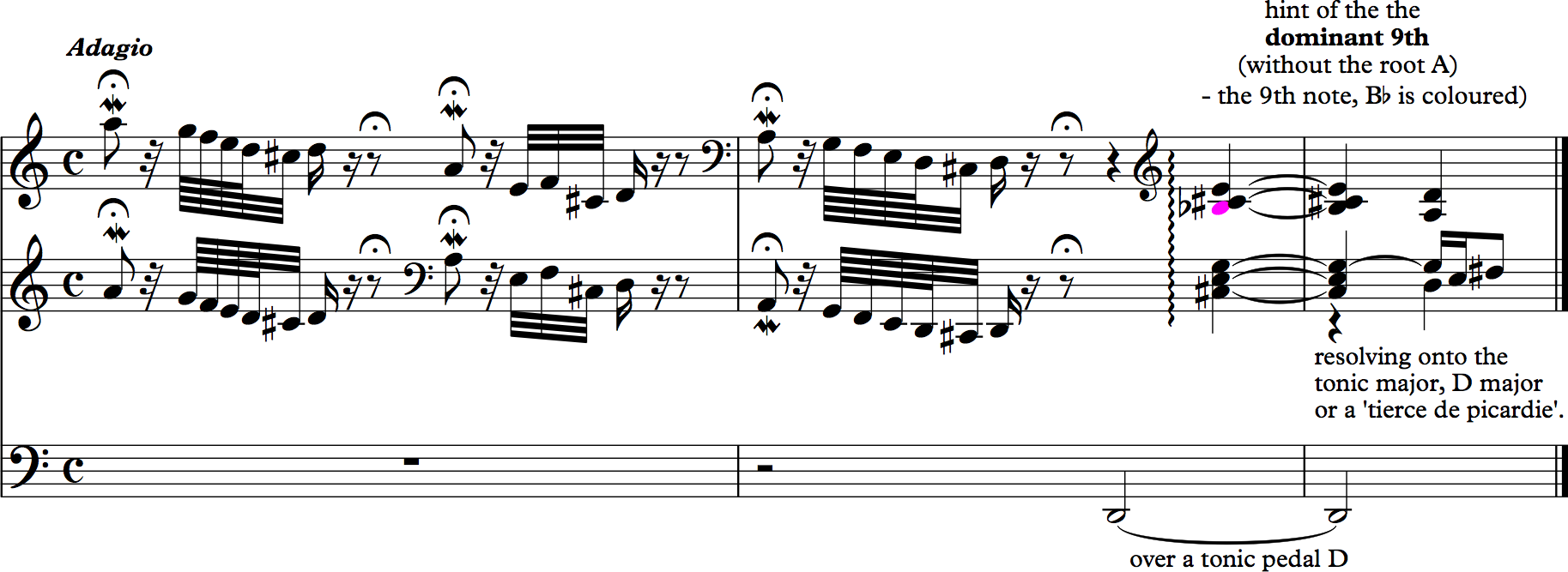C5 | Extended chords
What are extended chords?
- These are chords of the 9th, 11th and 13th. They can be dominant 9ths or chords built upon other 7th chords, such as minor or major 7ths.
- They are created by adding the interval of the 9th above the root to a 7th chord.
- One note might be omitted at times if there aren’t enough instruments (or fingers!) to play a full chord.
- In their inversions, extended chords can appear as an added 2nd or added 6th. The following examples might be of help.
1. Dominant 7th of C major ar G
Dominant 9th on G
The dominant 9ths (leaving out the F) creating a chord or 'triad+2'

2. Dominant 7th of E♭ on B♭
Dominant 11thof E♭ on B♭
the dominant 11th resolving onto the tonic - by using the note E♭ to achieve this.

The same chord once again, but used as an appoggiatura to fall to the D, thus creating a chain in chords on the dominant BB♭ pedal before resolving to the tonic, E♭.

B♭11
B♭9
E♭+6 over the tonic pedal, B♭
E♭
Bach: Toccata a Ffiwg in D minor
- We associate these chords usually with the Romantic era but they did exist long before then in the Baroque and Classical periods.
- A hint of this chord occurs in the following work, Toccata and Fugue in D minor by J.S. Bach. The work opens with a series of octave, then falling in pitch until a very chromatic chord is heard. There is a strong feel of a 9th chord here (with a flattened 9th) over a tonic pedal D before resolving onto the tonic chord, D minor with a suspension and a tierce de picardie.

and here’s the chord in its root position resolving onto the tonic:
Play the chords
Beethoven: Symphony no. 3 in E♭ major (Eroica)
- Here is now an example from the Classical period. In the Exposition section in the Symphony no. 3 in E♭ major (Eroica) by Beethoven, we hear a dominant 9th chord. (F/A/C/E♭/G♭). Think about this for a moment. The key of course is now B♭ major, being the end of the section of the 2nd Subject which is in the dominant key.
Listen to the following example. It starts with the Second Subject theme and the following dominant 9th chords occur in the next frame in the link. They are heard over a dominant pedal in B♭ major, preparing us for a codetta which will bring the Exposition to an end.

The dominant 9th chord is coloured. Can you rearrange the notes so that the chord is in its original root position format?
Ravel: Pavane Pour Une Infante Défunte
Pavanne – a slow, somewhat processional dance from the Baroque period which is linked with Spain. It’s also spelt as Pavan or Pavane. It’s usually in a 2 or 4 time and often in clear sections AA'/ BB' / CC', with variations after each main theme. Sometimes it’s linked with a dance called Galliarde. This dance is in 3 time.
Click on the opening video once more. The piece is called Pavane Pour Une Infante Défunte in G major by Maurice Ravel (literally a ‘dance for a dead child’).
What kind of sound does an extended chord have? Did you notice when playing the link in the previous step – the prelude La Cathedrale Engloutie – that unresolved dominant 7ths create a rather special atmosphere. With more extended chords, such as the 9th, 11th and the 13th, we can also create a special and magical mood.
This is not a dance for a dead child – Ravel himself said that what he had in mind when he composed the piece was a little princess dancing like in the painting by Veláasquez.
Chords beyond the 7th, namely the 9th, 11th and 13th. Calling them augmented chords may cause confusion and therefore, be careful and use the term extended chords.
